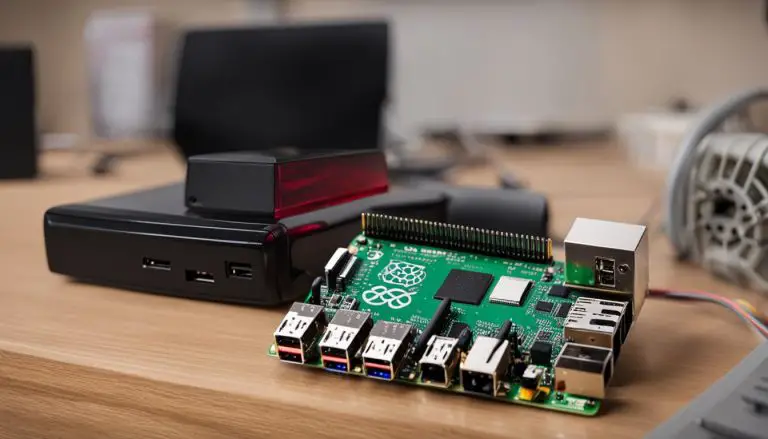Unveiling Portainer: What is Portainer and Its Usefulness?
Portainer is a powerful container management tool that simplifies the deployment and management of Docker and Kubernetes containers. With its user-friendly GUI and comprehensive features, Portainer makes working with containers easier, allowing users to apply best practices and enhance productivity.
Key Takeaways:
- Portainer simplifies the deployment and management of Docker and Kubernetes containers.
- It offers a user-friendly GUI, making container management more intuitive.
- Portainer allows users to deploy and manage containers, networks, volumes, templates, services, secrets, and environment variables.
- It supports centralized access management and permissions, ensuring secure container management.
- Portainer can be installed on Linux, Windows, and macOS platforms.
Exploring Portainer’s User-Friendly GUI
The graphical user interface of Portainer allows users to easily navigate and manage their containers, even without extensive technical knowledge. Whether you are a beginner or an experienced container developer, Portainer’s intuitive interface makes container management a breeze.
With Portainer, you can quickly deploy and manage containers, networks, volumes, templates, services, secrets, and environment variables—all from a single, user-friendly dashboard. No more complex command-line instructions or cumbersome configuration files. Portainer simplifies every step of the container management process.
One of the key features that sets Portainer apart is its visual representation of container resources. Portainer provides an interactive view of your containers, allowing you to monitor their status, resource usage, and logs in real-time. This visual representation makes it easy to identify any issues or bottlenecks and take immediate action to resolve them.
Reducing Complexity with Container Management
Portainer’s user-friendly GUI eliminates the need for deep technical knowledge, enabling even novice users to manage containers with confidence. By streamlining the container management process, Portainer allows you to focus on developing and deploying applications, rather than getting lost in complex configurations.
“Portainer’s user-friendly GUI simplifies container management, making it accessible to users of all skill levels.”
To ensure a smooth experience for every user, Portainer also provides comprehensive documentation and a vibrant community. If you ever get stuck or need assistance, you can quickly find answers to your questions or seek help from the friendly Portainer community.
Getting Started with Portainer
Are you ready to dive into the world of container management with Portainer? Getting started is easy. Simply install Portainer on your preferred platform—Linux, Windows, or macOS—and access the intuitive GUI through a web browser. Portainer provides step-by-step installation guides for each platform, ensuring a seamless setup process.
Once you have Portainer up and running, you can start deploying and managing containers with a few clicks. Explore the various features and functionalities offered by Portainer, such as managing networks, volumes, templates, services, secrets, and environment variables. With Portainer’s user-friendly GUI, container management has never been easier.
Table: Key Features of Portainer
| Feature | Description |
|---|---|
| Intuitive Dashboard | A user-friendly interface that simplifies container management and monitoring. |
| Real-time Resource Monitoring | Visualize container resources, including status, usage, and logs. |
| Comprehensive Documentation | Extensive documentation to guide users through installation and usage. |
| Vibrant Community | Active community for support, guidance, and sharing best practices. |
Key Features of Portainer
Portainer offers a wide range of features that empower users to deploy, manage, and monitor their containers efficiently. Let’s explore some of the key features that make Portainer a powerful tool for container management.
User-Friendly GUI
Portainer provides a user-friendly graphical user interface (GUI) that simplifies container management. Its intuitive design allows users to easily navigate and perform various tasks, such as creating and managing containers, networks, volumes, services, and more. With Portainer’s GUI, even users who are new to containerization can quickly grasp the concepts and start managing their containers effectively.
Full-Stack Application Deployment
Portainer goes beyond basic container management by offering full-stack application deployment capabilities. Users can deploy multi-container applications with ease, defining the necessary services, networks, and volumes for their applications. Portainer streamlines the process, allowing users to deploy complex applications and manage their components effortlessly.
Centralized Access Management
Security is of utmost importance in container management, and Portainer addresses this by providing centralized access management features. Users can define roles and permissions, ensuring that only authorized individuals have access to critical container resources. This granular control over access helps organizations maintain a secure container environment and prevent unauthorized access.
| Feature | Description |
|---|---|
| User-Friendly GUI | Portainer’s intuitive interface makes container management easier and more accessible for users of all levels of expertise. |
| Full-Stack Application Deployment | Portainer enables the deployment of complex, multi-container applications with simplicity and efficiency. |
| Centralized Access Management | Portainer allows for the management of user roles and permissions, ensuring secure access to container resources. |
With Portainer, users can take advantage of these powerful features and streamline their container management workflows. Whether you are new to containerization or an experienced user, Portainer’s comprehensive feature set will help you deploy, manage, and monitor your containers with ease. Its user-friendly GUI, full-stack application deployment capabilities, and centralized access management make it a versatile tool for container management in any environment.
Installing Portainer on Different Platforms
Installing Portainer is a straightforward process that can be done on various operating systems, providing flexibility and ease of use. Whether you’re using Linux, Windows, or macOS, you can easily set up Portainer and start managing your containers effectively.
Linux Installation
For Linux users, installing Portainer is as simple as executing a few commands in the terminal. You can either use Docker Compose or run Portainer directly as a Docker container. The official Portainer documentation provides detailed instructions for both methods, ensuring a smooth installation process.
Windows Installation
If you prefer using Windows as your operating system, worry not, as Portainer fully supports it. You can install Portainer by running the Docker Desktop application on your Windows machine. Once Docker is up and running, you can pull the Portainer image from the official Docker Hub repository and create a container using the Docker CLI or Docker Compose.
macOS Installation
Mac users can also take advantage of Portainer’s container management capabilities. To install Portainer on macOS, you’ll need to have Docker Desktop installed. Similar to the Windows installation process, you can pull the Portainer image from Docker Hub and create a container using Docker commands or Docker Compose.
By following the installation steps provided in the official Portainer documentation, you can quickly set up Portainer on your preferred platform and start managing your containers with ease. Whether you’re a Linux enthusiast, a Windows user, or a macOS fan, Portainer ensures a seamless installation process, making container management accessible to all.
| Platform | Installation Method |
|---|---|
| Linux | Execute commands in the terminal or use Docker Compose |
| Windows | Run Docker Desktop and create a container using Docker CLI or Docker Compose |
| macOS | Install Docker Desktop and create a container using Docker commands or Docker Compose |
A Step-by-Step Tutorial for Portainer Setup
Follow our detailed tutorial to quickly set up Portainer and unleash its powerful container management capabilities. Portainer is a universal container management tool that simplifies the deployment and management of Docker and Kubernetes containers. With its user-friendly GUI, it makes working with containers easier and more intuitive, even for beginners.
Step 1: Installation
First, download the Portainer installation package specific to your operating system from the official Portainer website. Once downloaded, follow the installation instructions provided. Portainer can be installed on Linux, Windows, and macOS platforms.
Step 2: Accessing the Portainer Dashboard
After successfully installing Portainer, open your preferred web browser and enter “http://localhost:9000” in the address bar. You will be redirected to the Portainer login page. Create an admin account and password. You can also choose to authenticate Portainer with an external authentication provider, such as GitHub or Azure AD.
Step 3: Connecting to Docker/Kubernetes
Once logged in, you will be prompted to connect Portainer to your Docker or Kubernetes environment. Select the appropriate option and provide the necessary connection details. If you are using Docker, Portainer will automatically detect and connect to your local Docker installation. If you are using Kubernetes, ensure you have the necessary credentials and API access.
Step 4: Managing Containers and More
With Portainer successfully set up and connected to your container environment, you can start managing your containers, networks, volumes, templates, services, secrets, and environment variables. Use the intuitive Portainer interface to create, deploy, and monitor containers effortlessly. Take advantage of its centralized access management and permissions features to ensure secure container management.
Portainer offers both a Community Edition (CE) and a Business Edition (BE). The CE is free and provides essential container management functionality. The BE includes additional advanced capabilities and is available for a subscription fee.
| Benefits of using Portainer |
|---|
| Increased efficiency in container management |
| Easy deployment and monitoring of containers |
| Enhanced productivity through a user-friendly interface |
Portainer serves as a valuable tool for managing containers in both Docker and Kubernetes environments. Its seamless integration with these popular container platforms allows for streamlined container management, making it an essential tool for developers, system administrators, and DevOps teams. With Portainer, you can effectively manage and monitor your containers, simplifying the process and optimizing your workflow.
Managing Containers with Portainer
Portainer streamlines container management by providing an intuitive interface to handle various aspects of container deployment and configuration. With its user-friendly GUI, Portainer simplifies the process of managing containers, networks, volumes, templates, services, secrets, and environment variables.
One of the key features of Portainer is its ability to simplify container deployment. Users can easily deploy containers by selecting from a range of pre-built templates or by creating their own. Portainer also allows for effortless scaling of container instances, enabling users to meet the demands of their applications effectively.
Container Monitoring and Troubleshooting
In addition to deployment, Portainer offers robust monitoring and troubleshooting capabilities. Users can monitor the performance of their containers, view resource usage, and access real-time logs. With Portainer, it becomes effortless to identify and resolve any issues that may arise during container operation.
Furthermore, Portainer supports container network management, allowing users to create and manage networks for their containers. This includes configuring network parameters, managing network access, and establishing connectivity between containers and external services.
| Key Features of Portainer: |
|---|
| Intuitive container deployment |
| Effortless scaling of container instances |
| Real-time monitoring and troubleshooting |
| Container network management |
Portainer’s comprehensive documentation provides users with detailed instructions on how to leverage its capabilities effectively. Whether you are new to container management or an experienced user, Portainer’s documentation serves as a valuable resource for understanding its features and optimizing your containerized applications.
With its versatility and ease of use, Portainer is a powerful tool for managing Docker and Kubernetes containers. Whether you are a developer, system administrator, or DevOps engineer, Portainer empowers you to streamline container management and enhance your overall productivity.
Centralized Access Management and Permissions
Portainer allows for centralized control over access and permissions, enhancing security and facilitating collaboration within container management teams. With Portainer’s user-friendly GUI, administrators can easily define and manage user roles and permissions, ensuring that each team member has the appropriate level of access to containers and resources.
Through Portainer’s role-based access control (RBAC) system, administrators can create and assign roles to users, granting them specific privileges such as read-only access, full control, or limited access to certain containers or namespaces. This granular control over permissions helps to prevent unauthorized access to sensitive containers and resources, reducing the risk of security breaches.
Furthermore, Portainer allows administrators to manage user accounts, including the creation, modification, and deletion of user profiles. User authentication can be integrated with existing authentication providers, such as LDAP or Active Directory, ensuring a seamless and secure login experience for team members.
Permissions Matrix
| User Role | Permissions |
|---|---|
| Admin | Full control over all containers and resources |
| DevOps Engineer | Access to specific containers and resources for deployment and management |
| QA Tester | Read-only access to containers for testing purposes |
By leveraging Portainer’s centralized access management and permissions, container management teams can work more efficiently and securely. The ability to assign appropriate roles and permissions ensures that team members have the necessary access to perform their tasks while also maintaining the integrity and security of the containers and resources.
Portainer’s Community Edition and Business Edition
Portainer offers a Community Edition (CE) for free and a Business Edition (BE) with advanced features and enterprise-grade support. Whether you’re an individual developer or part of a large organization, Portainer has the right edition to meet your container management needs.
The Community Edition of Portainer is ideal for small-scale deployments and personal projects. It provides essential features for managing Docker and Kubernetes containers, such as container deployment, management, and monitoring. With the CE, you can create networks, volumes, templates, and services effortlessly. It offers centralized access management and permissions, ensuring secure container management. The CE version is perfect for those who want to explore and experiment with containerization without any financial commitment.
For businesses and enterprises looking for advanced container management capabilities, Portainer’s Business Edition is the perfect choice. In addition to all the features available in the Community Edition, the BE provides extra functionalities, tailored specifically for large-scale deployments. The BE edition includes additional features such as role-based access control (RBAC), LDAP/AD integration, multi-tenancy support, and enhanced monitoring and alerting capabilities. It also offers dedicated enterprise-grade support and access to future updates and enhancements. The Business Edition is designed to meet the needs of organizations that require advanced container management capabilities, scalability, and comprehensive support.
In summary, Portainer’s Community Edition is a great starting point for individuals and small projects, while the Business Edition offers advanced features and support for organizations with larger container deployments. Choose the edition that suits your requirements, and enjoy the seamless container management experience that Portainer provides.
| Community Edition (CE) | Business Edition (BE) |
|---|---|
| Free of charge | Advanced features |
| Basic container management | Role-based access control (RBAC) |
| Essential features for small-scale deployments | LDAP/AD integration |
| Centralized access management and permissions | Multi-tenancy support |
| – | Enhanced monitoring and alerting |
| – | Enterprise-grade support |
Use Cases for Portainer
Portainer finds applications in a wide range of industries and scenarios, enabling streamlined container management across different use cases. Whether you are a developer, system administrator, or IT manager, Portainer provides a powerful and user-friendly solution to deploy and manage containers, helping you achieve maximum efficiency and productivity.
One of the primary use cases for Portainer is in development environments. With its intuitive GUI, developers can easily create and manage containers, allowing for rapid application development and testing. Portainer’s support for Docker and Kubernetes integration ensures seamless management of containers, enabling developers to focus on their core tasks without worrying about complex container configurations.
Another important use case for Portainer is in production environments. Portainer’s centralized access management and permissions feature provides enhanced security and control over container management, making it an ideal choice for large-scale deployments. IT managers can leverage Portainer’s capabilities to monitor and maintain containerized applications, ensuring high availability and reliability.
| Use Cases | Industry |
|---|---|
| Development environments | Software development |
| Production environments | Enterprises |
| Test environments | Quality Assurance |
| CI/CD pipelines | DevOps |
Portainer is also widely used in test environments, particularly in the field of Quality Assurance (QA). QA teams can leverage Portainer’s features to create and manage test containers, ensuring consistent and reliable testing processes. Portainer’s user-friendly interface simplifies test setup and execution, improving overall QA efficiency.
Furthermore, Portainer plays a crucial role in Continuous Integration and Continuous Deployment (CI/CD) pipelines. By utilizing Portainer, DevOps teams can seamlessly integrate container management into their CI/CD workflows, facilitating fast and reliable deployment of applications. Portainer’s ability to manage networks, volumes, templates, and services allows for efficient orchestration of containerized applications.
Whether you are a developer, IT manager, or part of a DevOps or QA team, Portainer offers a versatile solution for managing containers in various scenarios and environments. Its ease of use, extensive feature set, and compatibility with Docker and Kubernetes make it an invaluable tool in today’s containerized world.
Advantages of Using Portainer
Utilizing Portainer for container management brings numerous advantages, making the process more efficient and user-friendly. With its intuitive user interface and comprehensive features, Portainer simplifies the deployment and management of Docker and Kubernetes containers.
One of the key benefits of Portainer is its user-friendly GUI, which allows even novice users to easily navigate and manage containers. The intuitive interface provides a visual representation of containerized applications, making it easier to monitor and troubleshoot. Portainer’s GUI also enables users to apply best practices and configure containers with ease.
In addition, Portainer offers centralized access management and permissions, ensuring secure container management. This feature allows administrators to define user roles and grant specific permissions to individuals or groups. With fine-grained control over access, organizations can enhance security and enforce compliance.
Moreover, Portainer supports multiple platforms, including Linux, Windows, and macOS, making it accessible to a wide range of users. Whether you are using a single-node or multi-node environment, Portainer’s installation process is straightforward and well-documented.
| Advantages of Using Portainer: |
|---|
| Intuitive and user-friendly GUI |
| Centralized access management and permissions |
| Support for multiple platforms |
| Efficient deployment and management of containers |
In conclusion, Portainer offers a convenient and robust solution for container management. Its user-friendly interface, centralized access management, cross-platform compatibility, and efficient deployment capabilities make it an ideal choice for organizations of all sizes. With Portainer, users can effectively manage and monitor their Docker and Kubernetes containers, streamlining their containerization processes and enhancing productivity.
Understanding Portainer’s Role in Docker and Kubernetes Management
Portainer acts as a comprehensive management tool for both Docker and Kubernetes, simplifying container management across these widely used platforms. With its user-friendly GUI and extensive features, Portainer empowers users to efficiently deploy, monitor, and control containers, ensuring seamless integration with Docker and Kubernetes environments.
When it comes to Docker management, Portainer streamlines the process by providing an intuitive interface for managing containers, networks, volumes, and other resources. It allows users to easily create, start, stop, and delete containers, as well as manage container networks and access control. Portainer’s graphical representation of containerized applications simplifies troubleshooting and monitoring, ensuring the smooth operation of Docker containers.
Similarly, in the realm of Kubernetes management, Portainer plays a vital role in simplifying the deployment and orchestration of Kubernetes clusters. It enables users to manage nodes, pods, services, and deployments through its intuitive interface. Portainer also provides detailed insights into cluster performance and resource utilization, allowing administrators to make data-driven decisions to optimize containerized environments.
Key Benefits of Using Portainer in Docker and Kubernetes Management
- Simplified Container Management: Portainer’s user-friendly GUI makes it easy for users of all skill levels to manage containers, reducing the learning curve and improving productivity.
- Enhanced Visibility and Control: Portainer provides a comprehensive view of containerized environments, allowing users to monitor resource usage, troubleshoot issues, and take proactive measures to ensure optimal performance.
- Centralized Access Management: With Portainer, users can enforce access controls, manage permissions, and create teams, ensuring secure container management across multiple users and organizations.
- Compatibility and Flexibility: Portainer seamlessly integrates with Docker and Kubernetes environments, enabling users to manage containers across different platforms and easily switch between them.
By leveraging Portainer’s capabilities, organizations can streamline their container management processes, improve operational efficiency, and accelerate the adoption of Docker and Kubernetes technologies. Whether you are an individual developer, a small team, or a large enterprise, Portainer offers the tools and features needed to simplify and optimize container management.
| Key Features | Portainer |
|---|---|
| User-Friendly GUI | ✔️ |
| Container Deployment and Management | ✔️ |
| Network and Volume Management | ✔️ |
| Access Control and Permissions | ✔️ |
| Cluster Monitoring and Insights | ✔️ |
Conclusion
Portainer revolutionizes container management with its user-friendly interface, extensive features, and seamless integration with Docker and Kubernetes. As a universal container management tool, Portainer simplifies the deployment and management of Docker and Kubernetes containers, allowing users to deploy and manage a wide range of components, including networks, volumes, templates, services, secrets, and environment variables.
With its intuitive user interface, Portainer makes working with containers easy, even for users without extensive technical knowledge. Its GUI eliminates the need for complex command-line instructions, enabling users to apply best practices and efficiently manage their containers.
Additionally, Portainer supports centralized access management and permissions, ensuring a secure container management environment. Users can control and assign specific roles and privileges to individuals or teams, enhancing security and maintaining control over container operations.
Whether users are running Portainer on Linux, Windows, or macOS platforms, they can take advantage of its extensive capabilities. The tool offers a Community Edition (CE) for free, which provides essential features for container management. For users requiring additional advanced capabilities, there is also a Business Edition (BE) available.
In conclusion, Portainer empowers users to effectively manage and monitor Docker and Kubernetes containers. Its user-friendly interface, extensive features, and seamless integration make it an invaluable tool for both novices and experienced professionals in the container management space.
FAQ
What is Portainer?
Portainer is a universal container management tool that simplifies the deployment and management of Docker and Kubernetes containers. It offers a user-friendly GUI, making it easier to work with containers and apply best practices.
What can I deploy and manage with Portainer?
With Portainer, you can deploy and manage containers, full-stack applications, networks, volumes, templates, services, secrets, environment variables, and more.
Does Portainer support centralized access management?
Yes, Portainer supports centralized access management and permissions, ensuring secure container management.
On which platforms can I install Portainer?
Portainer can be installed on Linux, Windows, and macOS platforms.
Are there different editions of Portainer available?
Yes, Portainer offers both a Community Edition (CE) and a Business Edition (BE) with additional advanced capabilities.
How can I effectively manage and monitor containers with Portainer?
Portainer simplifies the process of deploying and managing containers, including networks, volumes, templates, services, secrets, and environment variables. It provides a user-friendly interface for easy container management and monitoring.
What are some common use cases for Portainer?
Portainer is extensively used in various use cases for container management, such as application development, microservices deployment, multi-cloud deployments, and container orchestration.
What are the advantages of using Portainer?
Using Portainer offers advantages such as increased efficiency, ease of use, enhanced productivity, simplified container management, and the ability to apply best practices.
How does Portainer integrate with Docker and Kubernetes?
Portainer seamlessly integrates with Docker and Kubernetes, providing comprehensive management capabilities for these popular container platforms.
- About the Author
- Latest Posts
Mark is a senior content editor at Text-Center.com and has more than 20 years of experience with linux and windows operating systems. He also writes for Biteno.com




